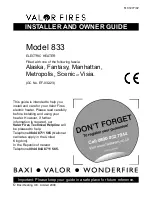
12
INSTALLATION INSTRUCTIONS
Removing the Old Water Heater
FIGURE 2.
1.
Turn “OFF” the gas supply to
the water heater.
If the main gas line shutoff valve
serving all gas appliances is used,
also shut “OFF” the gas at each
appliance. Leave all gas appliances
shut “OFF” until the water heater
installation is completed. See
Figures 2 and 3.
2.
Open a nearby hot water faucet
until the water is no longer hot.
When the water has cooled, turn
“OFF” the water supply to the water
heater at the water shut off valve
or water meter. Some installations
require that the water be turned off
to the entire house. See Figures 2
and 4.
3.
Check again to make sure the gas supply is “OFF” to the water
heater. Then disconnect the gas supply connection from the
gas control valve.
4.
Attach a hose to the water heater
drain valve and put the other end
in a
fl
oor drain or outdoors. (See
Figures 2 and 5.) Open the water
heater drain valve. The water
passing out of the drain valve
may be extremely hot. To avoid
being scalded, make sure all
connections are tight and that the
water
fl
ow is directed away from
any person.
5.
Disconnect the vent pipe from the draft hood where it connects
to the water heater. In most installations the vent pipe can
be lifted off after any screw or other attached devices are
removed. Dispose of the draft hood. The new water heater
has a draft hood which must be used for proper operation.
6.
If you have copper piping to the water heater, the two copper
water pipes can be cut with a hacksaw approximately four
inches away from where they connect to the water heater.
See Figure 6. This will avoid cutting off pipes too short.
Additional cuts can be made later if necessary. Disconnect the
temperature-pressure relief valve drain line. When the water
heater is drained, disconnect the hose from the drain valve.
Close the drain valve. The water heater is now completely
disconnected and ready to be removed.
FIGURE 6.
If you have galvanized pipes to the water heater, loosen
the two galvanized pipes with a pipe wrench at the union in
each line. Also disconnect the piping remaining to the water
heater. See Figure 7. These pieces should be saved since
they may be needed when reconnecting the new water heater.
Disconnect the temperature-pressure relief valve drain line.
When the water heater is drained, disconnect the hose from
the drain valve. Close the drain valve. The water heater
is now completely disconnected and ready to be removed.
Mineral buildup or sediment may have accumulated in the
old water heater. This causes the water heater to be much
heavier than normal and this residue, if spilled out, could
cause staining.
FIGURE 7.
FIGURE 3.
FIGURE 4.
FIGURE 5.
CHECK WITH
LOCAL UTILITY
FOR MINIMUM HEIGHT
3” MINIMUM
DRIP LEG
GROUND
JOINT
UNION
SUITABLE
DRAIN
MANUAL GAS
SHUT-OFF VALVE
6” MAXIMUM
AIR GAP
DISCHARGE PIPE
(DO NOT CAP
OR PLUG)
1
2
3
4
5
6













































